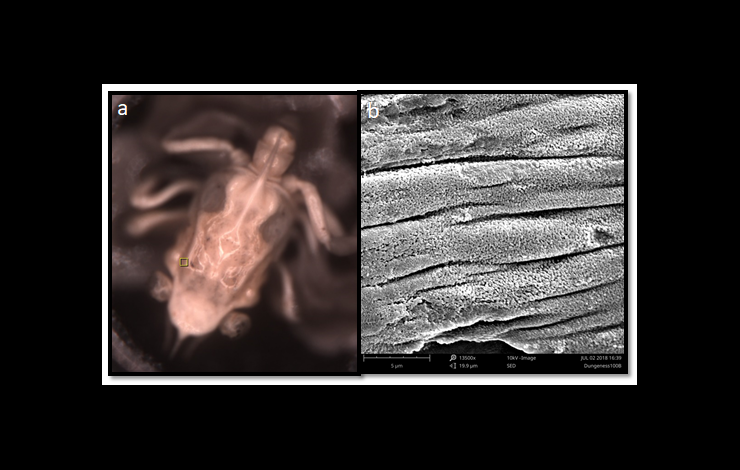Bednaršek, N., R.A. Feely, M.W. Beck, S.R. Alin, S.A. Siedlecki, P. Calosi, E.L. Norton, C. Saenger, J. Štrus, D. Greeley, N.P. Nezlin, and J.I. Spicer (2020): Exoskeleton dissolution with mechanoreceptor damage in larval Dungeness crab related to severity of present-day ocean acidification vertical gradients. Sci. Total Environ., 716, 136610. https://doi.org/10.1016/j.scitotenv.2020.136610
With annual revenues up to $220 million, the Dungeness crab (Metacarcinus magister) is one of the most valuable commercial fisheries on the US West Coast. Yet, rapid intensification of ocean acidification (OA) along the US West Coast is reducing natural habitats of crabs by increasing corrosiveness of the water due to the uptake of human-generated CO2. The steady increase in seawater CO2 can trigger multiple impacts that are most significant in the upper water column that is inhabited by Dungeness crab larvae, one of the most vulnerable life stages of the 4-year long life cycle of the crab.
To investigate the current health status of the larval Dungeness crabs, samples were collected during the NOAA Ocean Acidification Program West Coast OA cruise onboard the NOAA Ship Ronald H. Brown in May-June of 2016 and subsequently analyzed for relevant biological parameters (carapace dissolution and growth) and were related to the OA exposure conditions. The analyses showed extensive external and internal dissolution of the crab exoskeleton, which was the most pronounced in the nearshore coastal habitat where more intense OA conditions exist. While the carapaces of the offshore crabs appear intact, dissolving surfaces of coastal crabs have exposed crystals, ridges and folds (see Figure). In addition, OA conditions can cause a dissolution of the surfaces around the small, hair-like structures on the surfaces that are used by the crabs to detect sensory cues from the environment, resulting in their loss. Dissolution can induce energetic trade-offs, indirectly leading to slower growth, as demonstrated by smaller crab size co-occurring with more severe dissolution.
The results of these studies suggest that larval Dungeness crab are already compromised by conditions related to OA in their current habitats, with approximately 10% of the dissolution estimated to be due to the atmospheric CO2 increase over the last two decades. Despite such rapid biological changes, the impact at the population level is impossible to estimate at this time. Further analyses and demographic modelling efforts are needed to better understand the impacts of OA in combination with other climate change stressors.



